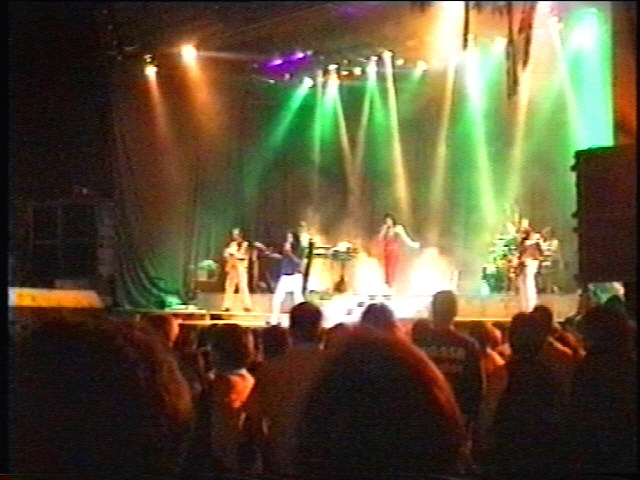The festival of "San Bartolomeu", Noia, Galicia
Noia has a 6 day long festival every year called "San Bartolomeu", normally during the third week of August. In 2005 it commenced on the 23 of August and the first Sunday of that week was also the "festival of the empanada". This festival has many events built around it, but the main ones are a series of night time concerts. These concerts start between 8.00pm and 10.00pm and continue well into the early hours. We have been there at 4.00am and they have still been going on.
Most evenings have two bands (they are called "orchestras" in Spain) and they blend a mixture of traditional Spanish music with international rock and pop. These bands are on permanent tour, playing at festivals all over Spain and many are quite well known. The larger groups have impressive stage rigs, some with video screens.
We were in Noia during the festival in 2003 and, after our initial skepticism, really enjoyed the music. We thought the best performers (by a mile) was a band called "Limon", but another group who originate from Noia, called "Paris de Noia", were the favourite with the locals.
All the bands arrived with a single large articulated truck which, over a two hour period, hydraulically metamorphosized into a large stage complete with lighting rig and multiple performance levels, it really had to be seen to be believed. In the case of Paris de Noia, their rig had video screens either side of the stage and a mobile hydraulic light set which moved up and down centre stage whilst supporting a band member.
Below, Limon performing in August 2003 in Noia's main town square.

All the (free) contemporary concerts take place in the main plaza, although there are some traditional brass bands who also perform at another smaller square behind "St. Martino" church in the mediaeval district.
In addition to the concerts you will, during festival time, continually hear bagpipes. The Galicians are Celts and have their own traditional dress and music (similar to that of Scotland). It bears no similarity to that of southern Spain. They also let off barrages of fireworks at 10.00am every morning and then on the hour there after, great if you want to sleep in.
Festival of the "Empanada"
Although contemporary music appears to be the main festival activity, there are many other more traditional and regional events. One of these is the festival of the empanada (a Galician pie) which you can sample as part of the procedings. When we were there you payed 2 euros for a slice of empanada and a glass of wine. Empanadas are a real speciality of the region and 2 euros for a fair sized slice is extremely good value - the seafood empanada I had was excellent.
A series of similar small events take place on a daily basis and you just decide what you want to see and what you don't. A few events may involve a small level of participation, but most take the form of some kind of show or performance you can watch.
Other fiesta events include:- A South American market, which lines one side of the main piazza and sells all manner of jewellery, bags and clothes (actually good quality and very cheap). The market opens mid morning and continues until the main night time fiesta events conclude. The market traders cover their stalls at the end of trading, but rather than pack them away, make up beds and sleep inside them.
A large children's fun fair (as in Britain/USA). This is located below the main town square and features all kinds of rides, many of which seem to be of as much interest to adults as children. Food is also on sale around the fair and there is usually a make-shift cafe under a canopy specializing in freshly fried pulpo (octopus).
Traditional music and dancing takes place on most festival days in one or more of Noia's town squares. Some of these displays are formal and involve a stage, whilst others appear almost impromptu and seem to happen without warning.
Various activities and shows to entertain and involve children. Some take place on a temporary stage erected in front of the town hall, whilst others use one of the smaller and older squares facing San Martino church.
Festivals also provide the Galicians with an opportunity to demonstrate their Celtic origins and this they do with great fervor. Every day during the festival of "San Bartolomeu" the morning is heralded in with the sound of bagpipes, the traditional instrument of Galicia. Galician dancers wearing outfits similar to those of their Scottish and Irish cousins also parade around the town's main square and, at times, it is hard to believe you are actually in Spain. The traditional colours of these costumes are black, accented with red and white.
Something I find interesting is that all of the festival events, both traditional and modern, attract an equal balance of the generations. Furthermore, those in their teens and early twenties donít seem embarrassed or uncomfortable being seen having a good time in public in the company of much older people, it makes you wonder why the same is not true in other counties, notably mine!
On the final night of the festival of "San Bartolomeu", there is a spectacular firework display over the bay. It lasts about 20 minutes, is watched by several thousand people and is impressive, even by the standards of "Disney's" theme park displays. It is also quite an emotional event because it signals the end of the main festival and, to a degree, the end of Noia's summer holiday season.

